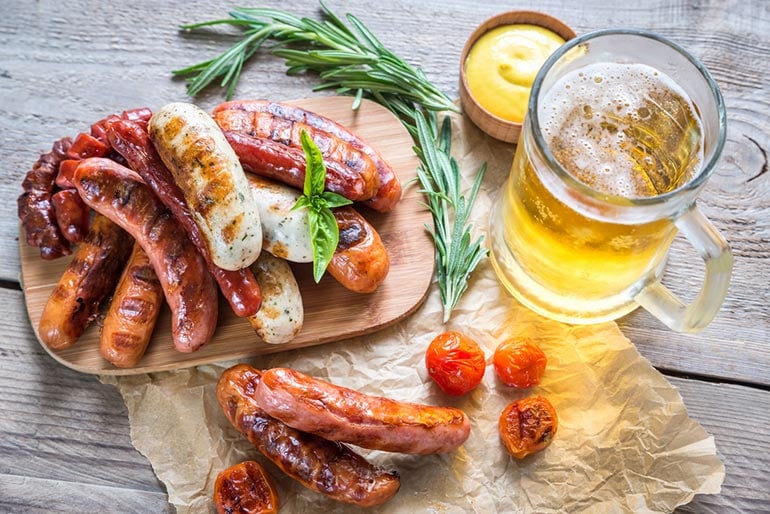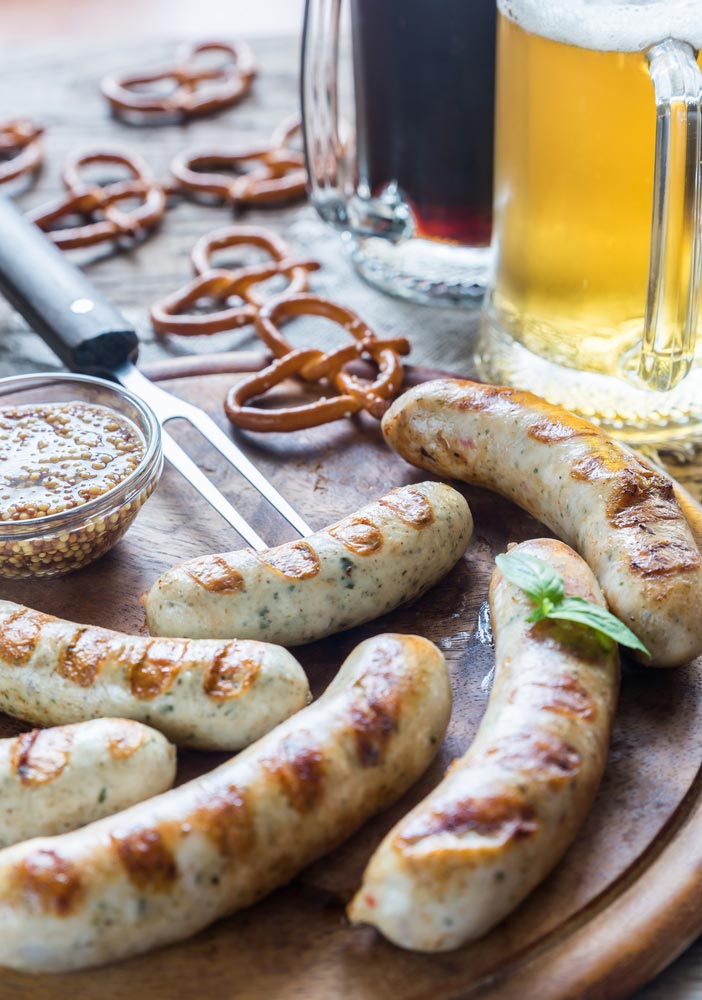Start 14-Day Trial Subscription
*No credit card required

Cooking Bratwurst with Craft Beer: A Wisconsin Tradition Perfected
There’s only one wedge issue in Wisconsin that’s bigger than union labor. The state is deeply divided on craft beer and brats. When should they meet and under what circumstances?
My friend Harvey backed the silver with red leather interior Jaguar XJ6 dead center between two grubby, garbage-strewn campsites that were pitched near the Turn 3 fence at Road America.
Located in the glacially carved swells of Wisconsin north of Milwaukee, the track’s four miles of undulating asphalt had been drawing sports car racers and fans from all over the world for almost two decades. The neighbors covered in dried mud – who obviously were on, like, Day 4 of their stay – rubbed party-ravaged eyes as Harvey began setting up our little section of ground on that hot, muggy afternoon in the early 1970s.
Out of the Jag came coolers, collapsible chairs, a small folding table, and a full-sized Weber kettle in immaculate black, ready for assembly. Briquettes were lit and out came a six-pack of Schlitz cans – the kind you needed a “church key” to open. To the horror of the neighbors, the beer was dumped into a foil pan on the grill rack.
A plastic bag of onions was dumped into the beer and then a stick of butter. The pan was placed over the hot grill until bubbles and steam began to rise. Then a large bag of brats, from the cooler, was emptied into the pan.
About this time, the pace car came up over the small hill out of Turn 2 and led the snarling and bellowing field of sports cars past us on their warm-up lap.
Several roaring, full-speed laps later, the brats were deemed sufficiently boiled and the coals at the right temperature to remove the butter/onion jacuzzi from the Weber and put the gleaming sausages on the grill grate.
Three laps of constant tending later, the brats had browned up and were shooting mini-geysers of juice onto the briquettes as the cars wailed past. Into the buns and onto paper plates they went.
The neighbors, who had watched the two hoity-toity University of Wisconsin Madison alums with mild disgust were waved over for hot brats and beer that was actually cold. Harvey could have been appointed pope had the mud-crusted neighbors been elector cardinals.
Those lovingly prepared German sausages were memorable. Juicy, perfectly browned, and that wonderful masticated blend of onions and hops. The snap of the casing, the burst of steam, the rivers of liquefied fat.
That was not the first time I’d had beer brats. Just the best time. Brats, beer, and the supercharged drama of sports car racing. Terrific.
There was hardly universal agreement on the new approach to a very old food tradition. Not everybody liked it, but around the time of that muggy day at Road America, boiling brats in a beer bath became a craze. Bad beer, lore had it, turned great bratwurst into tremendous bratwurst. And in Wisconsin, all the proper ingredients were both near and dear.
A Recipe For Cooking Brats With Craft Beer
Let’s explore a step-by-step process to create brats that are not only infused with the unique character of your chosen craft beer but also enhanced by a savory blend of delightful ingredients. Prepare to elevate your bratwurst experience with a dish that combines the hearty essence of traditional brats with the distinctive notes of your favorite craft beer.
Ingredients
- 6 bratwursts (fresh or pre-cooked)
- 1 can or bottle of craft beer (a pale ale, IPA, or amber ale works best)
- 1 large onion, thinly sliced
- 2 cloves garlic, minced
- 2 tablespoons olive oil
- 1 tablespoon brown sugar
- 1 tablespoon Dijon mustard
- 1 tablespoon Worcestershire sauce
- 1 teaspoon smoked paprika
- 1 teaspoon dried thyme
- Salt and pepper to taste
- Optional: 1 cup sauerkraut (for serving)
- Optional: 6 bratwurst buns
Instructions For Craft Beer Brats Recipe
Step 1. Prepare the Ingredients
Slice the onion and mince the garlic. If using fresh bratwursts, prick them with a fork to prevent bursting during cooking.
Step 2. Sear the Brats
Heat a large skillet or grill pan over medium-high heat and add the olive oil. Add the bratwursts and cook them for 3-4 minutes on each side until they are browned. They don’t need to be fully cooked through at this stage. Remove the brats from the pan and set aside.
Step 3. Sauté Onions and Garlic
In the same skillet, add a little more olive oil if needed. Add the sliced onions and cook for about 5 minutes until they start to soften. Add the minced garlic and cook for an additional minute, stirring frequently.
Step 4. Add Beer and Seasonings
Pour the craft beer into the skillet with the onions and garlic. Stir to combine. Add the brown sugar, Dijon mustard, Worcestershire sauce, smoked paprika, dried thyme, salt and pepper. Stir well to combine and let it simmer for 2-3 minutes to allow the flavors to meld.
Step 5. Simmer the Brats
Return the bratwursts to the skillet, nestling them into the beer and onion mixture. Reduce the heat to low and cover the skillet. Simmer for 20-25 minutes, turning the brats occasionally, until they are cooked through and have absorbed the beer flavor.
Step 6. Optional: Add Sauerkraut
If using sauerkraut, add it to the skillet in the last 5 minutes of cooking. Stir it into the mixture to warm it up and let it absorb some of the flavors.
Step 7. Serve
Remove the brats from the skillet and let them rest for a couple of minutes. Serve the brats on buns with the beer-infused onions and sauerkraut (if using) on top.
Tips
- Choose a craft beer that complements the flavor of the brats. A hoppier beer can add a nice contrast, while a maltier beer will enhance the richness of the brat.
- For a smoky touch, try adding a bit of bacon or smoked sausage to the skillet.
- This recipe can be made ahead of time and reheated, making it perfect for gatherings.
Enjoy your flavorful craft beer brats!
To Brat or Not to Brat
The Milwaukee area was a favorite destination for emigrating Germans in the early and middle decades of the 20th Century. Among those émigrés were some of the finest sausage makers (or wurstmachers) and brewers in the world.
Many of the names of the higher-quality brewers are familiar: Schlitz, Pabst, Miller, Heileman, Blatz. The names of the sausage makers are less known nationally but revered by the locals. At some point along the way, their products found their way into the same pots, and cookouts have never been the same in the Badger State.
“It’s definitely a regional preference,” Megan Dorsch of Nueske’s Applewood Smoked Meats in Wittenburg, Wisconsin says of hot-tubbing brats and beer. “We Wisconsinites love brats and I think that anyone who is eating a fresh, unsmoked brat around here, we love giving them the beer bath first.”
The ingredients – with personalized twists (like seasoned salt, red pepper flakes, hot peppers, garlic) – remain constant: Sheboygan-style bratwurst, cheap lager, chopped onion, and butter.
The process is also inflexible. Boil until sausages are cooked and plumped and then, low and slow (split casings kill the gig) over charcoal or gas burners. “It adds flavor,” Dorsch says. “It gives it a rich flavor and it’s just tradition here in Wisconsin.”
Virtually everybody in Wisconsin agrees beer and brats are essential together. Not everybody agrees on what point in the process they should get together. Forget about taking sides on Governor Scott Walker’s anti-union campaign. How do you like your brats?
College friend Rob Reuteman just won’t take the plunge on beer brats. “I think it’s stupid,” said Reuteman, a native of Wauwatosa.“If you boil brats in beer, all the essential spices bleed out of the brat into the beer. You’re left with a less tasty brat.”
Jon Gabe of Usinger’s in Milwaukee also says nein to beer brats.
“At Usinger’s, we are not fond of cooking brats in beer,” Gabe said. “Similar to a brewer who carefully crafts a beer, the Usinger wurstmachers make sausages that are spiced just right. When cooked in beer, the flavor and consistency of the brat changes. We are firm believers that brats and beer go together. However, drink the beer and grill the brats, but that is as close as the two should get.”
Gabe offered to send The Beer Connoisseur some brats gratis – if we promised not to mix them with beer until they were separately introduced to the mouth.
Joseph Conrad was born, raised, and fed at ground zero of the ground zero of American wurst making – Sheboygan. He has a third take on beer, brats, and their mating habits – a simmering pot of onions, butter, and beer.
“OK,” Conrad said, “this whole boiling brats in beer stuff is pretty hokey to real Sheboygan Germans. When I was growing up you always had a simmering pot for the grilled brats and that’s where you put them AFTER the grilling.
“I still like the original method I grew up with but, with enough good beer – not the cheap stuff we’d use in the simmer pot – it’s all good.”
Good Sheboygan Germans also apparently either abhor waste – or love flavor.
“A little-known thing was that the mess left in the simmering pot after the original barbecue grilling, eating, and partying could be made into what we called brat soup by adding more cans of beer, cutting up the leftover brats into chunks, heating and then eating,” said Conrad. “You needed a young and strong stomach though for that.”
The strength of the stomach also comes into play when choosing condiments. Those considered semi-essential include sauerkraut and a strong German-style mustard. Nothing green should ever top a brat.
My personal preference here is ‘kraut, standard yellow mustard, and a hearty smear of horseradish. Another personal preference is avoiding the big, doughy rolls that make sausages look so Martha Stewart-fake in advertisements. A good hot dog bun off a supermarket shelf will allow more taste to seep through than will a “roll” from an upscale French bistro.
The bottom line on beer brats is a wonderful one from Conrad, which beer lovers certainly should be able to get behind.
“We do not advocate the par-boiling method,” he said, “but we never ever turn down good-cooked brats regardless of the method used. Correction, we would turn them down if inadequate supplies of GOOD beer were not provided.”
With in-state craft brands like New Glarus, Stevens Point, and Lakefront, among others, currently competing with the traditional German-American brewers, there’s plenty of good beer available until this debate is resolved. Or not!

Frequently Asked Questions
What makes bratwurst different than sausage?
Bratwurst is a specific type of German sausage, typically made from pork, veal or beef. It is seasoned with spices like nutmeg, ginger and caraway, giving it a distinct flavor compared to other sausages.
Should bratwurst be boiled or grilled?
Bratwurst can be both boiled and grilled. Boiling first helps cook the sausage evenly, while grilling adds a delicious char and enhances the flavor. Many prefer to boil and then grill for the best results.
How is bratwurst traditionally served?
Bratwurst is traditionally served in a bun with mustard, sauerkraut or grilled onions. In Germany, it's often enjoyed with sides like potato salad or pretzels, and accompanied by a cold beer.
Are Johnsonville brats beef or pork?
Johnsonville brats are primarily made from pork. They may include a blend of other ingredients, but pork is the main meat used in their bratwurst products.
Can you get beef brats?
Yes, beef brats are a common brat variant.
How long should I boil brats before grilling?
Boil brats for about 10-15 minutes before grilling. This helps cook them through and ensures they stay juicy. After boiling, grill them for about 5-7 minutes per side to achieve a nice char and enhance the flavor.
Does boiling brats dry them out?
Boiling brats can cause them to lose some moisture, but if done properly, they shouldn't become overly dry.
What's the difference between beer brats and Italian sausage?
Beer brats are typically pork sausages simmered in beer, which adds flavor and moisture. Italian sausage, on the other hand, is seasoned with herbs and spices like fennel and basil and is usually cooked without beer. The key differences lie in their flavor profiles and seasoning.
Can I use brats instead of Italian sausage?
Yes, you can use brats instead of Italian sausage, but it will alter the flavor profile of your dish.
What is the difference between beer brats and bratwurst?
Beer brats are a type of bratwurst that are simmered or cooked in beer, which imparts a rich flavor and can make the sausage juicier. Bratwurst, on the other hand, refers to the sausage itself, which can be cooked in various ways, such as grilling, pan-frying or boiling, and is not necessarily prepared with beer.
Do Germans eat bratwurst on a bun?
Yes, Germans often eat bratwurst on a bun, especially at casual gatherings and street food stalls. This is similar to the way bratwurst is served in other countries, typically with mustard, sauerkraut or onions.
Are Cheddar brats pork?
Yes, Cheddar brats are typically made from pork. The cheddar cheese is mixed into the pork sausage to add a cheesy flavor.
Should brats be pierced before cooking?
Brats generally should not be pierced before cooking. Piercing can cause the juices to escape, which may result in a drier sausage. Instead, cook them over medium heat and turn them frequently to ensure even cooking and retain moisture.
Do Germans put mustard on bratwurst?
Yes, Germans often put mustard on bratwurst. It's a traditional and popular condiment that complements the flavors of the sausage.
When was bratwurst invented?
Bratwurst dates back to the early 14th century in Germany. The term "bratwurst" itself is derived from the German words "brät" (finely chopped meat) and "Wurst" (sausage). The sausage has evolved over time, with various regions in Germany developing their own unique recipes and flavors.
When is bratwurst day?
Bratwurst Day is celebrated on August 16. This unofficial holiday honors the bratwurst sausage and its place in culinary traditions, especially in Germany and the United States.
When is the bratwurst festival in Bucyrus, Ohio?
The Bratwurst Festival in Bucyrus, Ohio typically takes place in mid-August. This annual festival celebrates bratwurst with food, entertainment and various activities for visitors.
What temperature do bratwurst need to be?
Bratwurst should be cooked to an internal temperature of 160°F (71°C) to ensure they are safe to eat and fully cooked. Use a meat thermometer to check the temperature for accuracy.
Why are bratwurst a white color?
Bratwurst is white due to the type of meat used and the cooking process. Traditional bratwurst is made from pork or veal, which are lighter in color than beef.
Why are bratwurst curved?
Bratwurst is curved because of the natural casing used in making the sausage. The casing, typically made from the intestines of pigs or sheep, has a natural curvature. When the sausage is stuffed and linked, it naturally takes on this curved shape.
Are bratwurst bad for you?
Bratwurst can be enjoyed in moderation as part of a balanced diet. However, they are high in fat, sodium and calories, so regular consumption may contribute to health issues like heart disease and high cholesterol.
How long will bratwurst last in the refrigerator?
Uncooked bratwurst will last in the refrigerator for 1-2 days, while cooked bratwurst can be stored for 3-4 days. To maintain freshness, keep them in an airtight container or tightly wrapped in plastic wrap or foil.
Are bratwurst gluten free?
Bratwurst is often gluten-free, as it’s typically made from meat, spices and herbs. However, some brands may add fillers or seasonings containing gluten, so it's essential to check the label or confirm with the manufacturer.
Are bratwurst keto friendly?
Yes, bratwurst is typically keto friendly because it’s high in fat and protein while low in carbohydrates.
Are bratwurst carnivore?
Yes, bratwurst is generally considered carnivore-friendly as it is made primarily from meat. However, some varieties might include non-carnivore ingredients like spices, fillers or preservatives, so it's best to check the ingredient list if you're strictly following a carnivore diet.
What are bratwurst ingredients?
Bratwurst typically contains pork, beef or veal, mixed with fat, salt, pepper and spices like nutmeg and marjoram. Some varieties include additional seasonings or fillers.
Can bratwurst be pink in the middle?
Yes, bratwurst can be pink in the middle due to its seasoning and the curing process.
Can bratwurst be cooked in an air fryer?
Yes, bratwurst can be cooked in an air fryer. Preheat the air fryer to 360°F (182°C) and cook the bratwurst for about 12-15 minutes, turning halfway through, until they reach an internal temperature of 160°F (71°C).
Can bratwurst be refrozen after thawing?
It’s generally not recommended to refreeze bratwurst after thawing, as this can affect its quality and increase the risk of bacterial growth. If you need to refreeze, ensure it was thawed in the refrigerator and not at room temperature.
Can you boil bratwurst in water?
Yes, you can boil bratwurst in water. Place them in a pot, cover with water or beer and bring to a boil. Reduce heat and simmer for about 10-15 minutes until cooked through.





